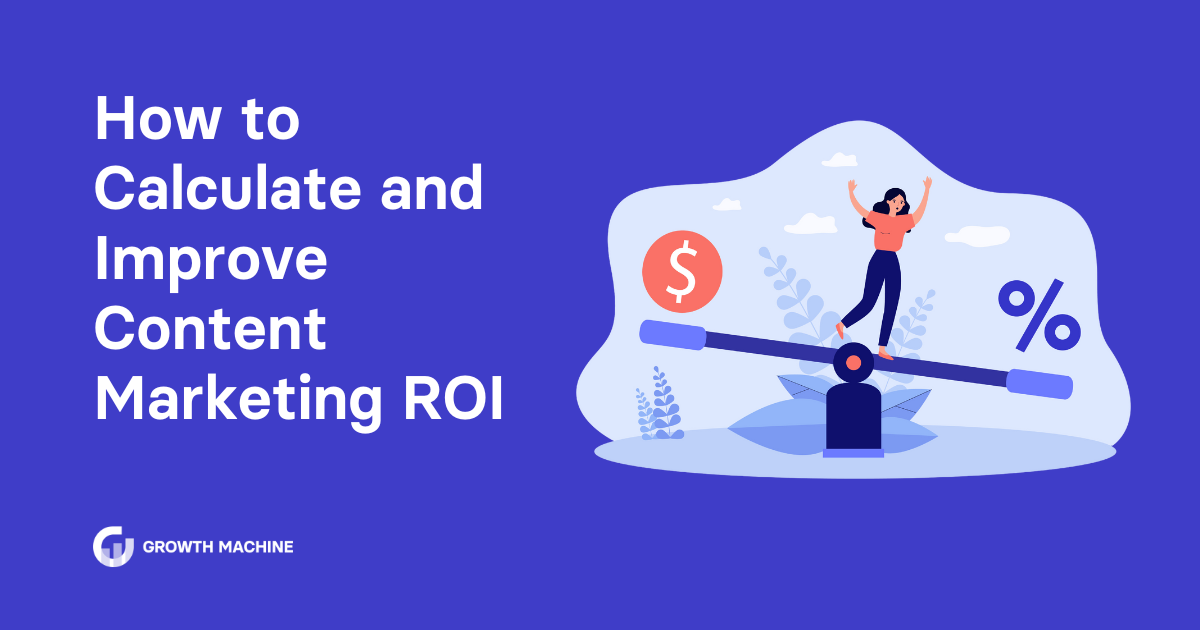How to Calculate and Improve Content Marketing ROI
If you’re feeling unsure about the impact your content is having on your business, you’re not alone. In fact, a report from Uptempo found that 61% of marketing leaders struggle to effectively measure return on investment, or ROI.
Measuring content marketing ROI doesn’t have to be overly complicated. By setting clear goals for your content and looking at the right metrics, you can figure out which types of content are making the biggest impact on your bottom line.
In this guide, we’ll explain exactly how to calculate the ROI of content marketing and how your marketing team can use those insights to create better content and make more strategic decisions for your business.
What Is Content Marketing ROI?
In a content marketing context, ROI is a measure that compares how much value your content generates vs. how much you invest in content creation, optimization, and distribution over a set period of time.
While each business may define value differently, a positive return will typically take the the form of greater brand awareness, more website traffic, increased engagement, or higher conversion rates. These are all metrics that can be tied to increased revenue for your business — more on that below.
Why Is It Important to Measure ROI?
By measuring the ROI of your content marketing efforts, you can clearly identify your most successful content marketing campaigns, channels, and assets, then adjust your content marketing strategy accordingly.
Calculating ROI is also useful for demonstrating the value of your content marketing efforts to your team or stakeholders. Whether you’re seeking additional marketing budget to expand your content efforts or showcasing how great the results were from your latest content marketing campaign, it’s pretty tough for people to refute you when they have the numbers neatly laid out in front of them.
Calculating content ROI can also help you pump the brakes on content that’s not performing so well, so you can focus your time and energy where it really counts.
For example, if 90% of your customers are acquired through your company’s blog, it only makes sense to increase your investment in content and search engine optimization (SEO).
Measuring Content Marketing ROI
Before we dive into how to calculate your content ROI, it’s important to understand your content marketing goals.
After all, if you don’t have goals to work towards, it’s impossible to tell whether you’re succeeding or failing. You might spend years publishing content for your startup or small business, with no idea of whether or not it’s contributing to your growth. That adds up to a lot of unnecessarily wasted time and effort.
How to Set Content Marketing Goals
Your content marketing goals will determine which metrics you should track and how you should measure success. This allows you to evaluate the effectiveness of your content efforts, and make data-driven decisions to optimize your strategy for maximum ROI.
Setting marketing goals isn’t as simple as throwing out obscure numbers like “100,000 visitors a month.” What’s needed is a more detailed set of goals that give you a sense of which direction your business is headed and whether or not your content supports that growth.
That’s where SMART goals come in. SMART goals are Specific, Measurable, Achievable, Relevant, and Time-Bound.
For example, instead of setting a goal like “100,000 visitors a month,” you might set a more realistic goal like, “We will generate two pieces of new content each week with the goal of generating 50% more traffic to our landing pages by the end of Q3.” You can see how in the latter example, the outcomes are much more in your control and clearly demonstrate how your content supports your overall business goals.
Which Metrics Matter for Content Marketing ROI?
The most important thing is to understand what a positive return looks like for your business, then assign that return a numerical value.
For example, if a gated download or whitepaper brings you an average of 50 leads per month, and approximately 10 of those leads convert to a sale, you can assign a numerical value to each lead generated from that piece of content.
KPIs, or key performance indicators, can help you understand exactly which data points to look at. A KPI in content marketing refers to a measurable metric your business can use to evaluate the success of your marketing campaigns or strategy. They include metrics such as website traffic, lead generation, conversion rates, and social media engagement.
Let’s break each of these down in more detail:
- Web traffic: One of the most obvious metrics of success is website traffic. Look at overall traffic as well as the traffic that each landing page or blog post is bringing to get a full picture. If your content marketing efforts are driving more traffic to your website, that’s usually a positive sign that your strategy is working.
- Lead generation: When it comes to ROI, it can be tempting to jump right to how much revenue or sales are earned from your content efforts. But lead generation is equally important to measure, since more leads typically translates to higher sales and a positive impact on your digital marketing ROI.
- Engagement: Often overlooked, engagement is an important metric to consider when it comes to content performance. Are people commenting on your blog posts or sharing them on social media? Are they clicking your backlinks and spending a good amount of time on a specific page? If so, that’s a good indication that your content is resonating with your target audience.
- Conversion rates: Ultimately, your content marketing efforts should result in more conversions — whether that’s sales, new leads, or another type of conversion. It helps to assign a value or dollar amount to each conversion, as this will be the best measure of how much revenue your content investment is generating for your business.
How to Calculate Content Marketing ROI
Calculating ROI is not always one-size-fits-all. Some businesses will use slight variations of the marketing ROI formula below, so feel free to adjust your ROI calculation as needed, depending on your goals.
To calculate your ROI, subtract the costs of your content marketing from the returns, and divide that by the cost. The result will be a percentage that represents your return on investment.
Content Marketing ROI = [(Returns from Content Marketing – Costs of Content Marketing) / Cost of Content Marketing]
Let’s break this down a bit further:
- Returns from Content Marketing: Consider this the amount of value or business you’ve generated from your content marketing efforts. It could include things like increased website traffic, engagement, leads, or sales — whatever metric you’ve chosen to focus on based on your goals.
- Cost of Content Marketing: The total amount of money you’ve invested in your content marketing efforts. To figure out how much your content marketing efforts are costing you each month, factor in things like content creation costs (e.g., writer or designer fees), the cost of promoting your content (e.g., ad spend), and any other associated costs.
When calculating ROI, what you should be looking for is a positive number. If your value comes out as a negative, that means you’re currently spending more on content creation than you’re earning. That is a red flag that it’s time to re-evaluate your content strategy.
For example, let’s say you spent $5,000 on content creation, optimization, and distribution last month, and generated $10,000 in sales as a result. Using the formula above, your ROI would be:
ROI = [($10,000 – $5,000) / $5,000] = 1
In this case, your ROI would be 1, meaning you generated a positive return on your content marketing.
Tools for Measuring Content Marketing ROI
Measuring ROI doesn’t have to be overly complicated. Having the right tools in place can even make the process relatively effortless. But which tools are most helpful for measuring content marketing ROI? Here are some of our go-to’s:
- Google Analytics: This is a tool that every content marketer should be familiar with. Not only can it give you all kinds of data on your website and landing pages, but you can also track conversions to see which channels and content pieces are driving the most traffic for your business.
- UTMs: A UTM is a piece of code attached to the end of your links that you can use to track the ROI on your marketing campaigns. UTM parameters include the source, medium, and campaign name of your traffic source, which can be incorporated into your blog post URLs, calls-to-action, and sharing links for social media or email marketing campaigns.
- HubSpot: When it comes to detailed analytics and reporting tools, it doesn’t get much better than HubSpot. By tracking which leads and potential customers are interacting with your content, you can get a fuller picture of how your content is contributing to your revenue growth. Bonus: HubSpot can help manage your content distribution through social media, email campaigns, and even your sales pipeline.
- CRM software: A customer relationship management (CRM) software like Salesforce or Zoho allows you to track your customer journey in order to demonstrate which pieces of content are having the biggest impact on lead generation and revenue. The nice thing about connecting your content to your CRM data is that typically, customers will be assigned a monetary value within your CRM. This gives you a clear return to plug into your formula, which makes calculating content ROI 10x easier.
- Social media analytics: The built-in analytics tools on each social media platform are helpful for tracking. If you’re using social media to promote your content, learning how to interpret data from platforms like Facebook insights or Twitter analytics is an absolute must. By connecting your revenue data to metrics like engagement, click-through rates for your link in bio or ads, and Instagram shop sales, you can gain a better understanding of how social media is contributing to your bottom line.
How to Increase Content Marketing ROI
As much as we’d like to earn a high return on investment with every piece of content we create, the reality is that there will always be campaigns that miss the mark. If your ROI calculation is coming up as a negative number, here are a few changes you can make to bump that number up into the green:
Improve Content Quality
The better your content is, the more likely it is to generate a positive ROI. High-quality content tends to be engaging, informative, well-researched, and well-written. It’s also more likely to include messaging that is closely tailored to your audience’s unique challenges, experiences, and desires. As a result, it’s more likely to attract and retain readers, and has a higher chance of converting those readers to customers.
Looking to create content that actually converts? Leverage the expertise of our 1,000+ writers. We match you with content experts for your niche and strategically produce SEO-focused content for you, so you get blog content that drives web traffic that converts.
Re-Evaluate Your Channel Strategy
Customers expect to engage with you in multiple ways. Your job as a content marketer is to cut through the noise and figure out which of these distribution channels has the greatest impact on your bottom line.
If you’re not seeing the content ROI you want, it could be because you aren’t using the right channels to talk to your customers. To make the most of your content marketing efforts, you’ll want to consider everything from blogging and social media to whitepapers and case studies, depending on the kind of business you run.
For example, you might be killing it on Instagram and LinkedIn, but aren’t producing regular content for your blog. A 2022 report by HubSpot found that companies that prioritize blogging are 13x more likely to have a positive ROI on their marketing efforts, meaning that if you aren’t utilizing blogging for your business, now is the time to start.
Optimize Content for SEO
It’s frustrating when you pour hours into creating content, just to have it not rank as well as you hope on Google or drive a significant amount of traffic.
If you’re finding yourself in this situation, it could be that your content isn’t properly set up for Google to take notice.
Optimizing your blog content for SEO is one of the best ways to boost your content ROI. Improving your SEO rankings can increase your online visibility and drive more organic traffic for your business, making it more likely that your content will reach your target audience.
By increasing the likelihood of your content being discovered by potential customers, you’re likely to capture more traffic and more leads. This is usually a surefire path to more revenue and a positive impact on your overall content ROI.
Maximize Your ROI With Content That Converts
By calculating ROI, your company can determine how successful your content marketing efforts are and which content channels are having the biggest impact on your bottom line.
Once you have an understanding of which campaigns, channels, and assets are most successful, you can adjust your strategy and invest in the content areas that are actually driving results for your business.
By working with a partner that understands how to create content that converts, you can be confident that you’ll get the highest return on your marketing spend in the form of more leads, more customers, and ultimately, more revenue for your business.
Contact us to learn more about the approach we’ve used to grow client blogs to 100,000+ monthly visitors within a year and more than double their existing traffic.







